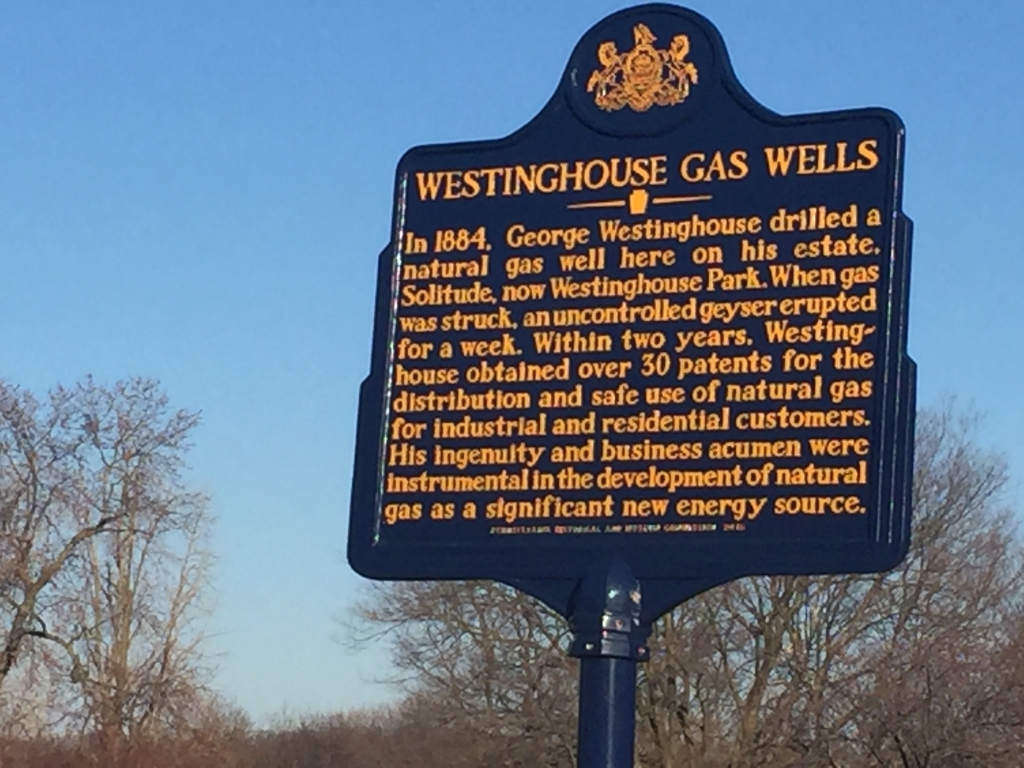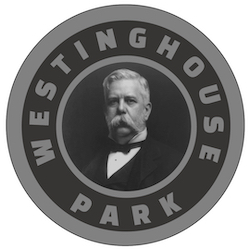

Celebrating its centennial in 2018, Westinghouse Park is a 10.2-acre city park situated in Pittsburgh’s East End neighborhood of Point Breeze North. It is defined by Thomas Boulevard on the south, the busway/railroad tracks on the north, Murtland Street on the west, and Lang Avenue on the east.

Here are three bird’s eye views of Westinghouse Park today.

Seen from above

Looking to the southwest

Looking northeast to Homewood
From 1871 to 1918, the site was “Solitude,” the estate of George Westinghouse Jr. and his wife Marguerite, pictured here with her younger sister.

In 1871, George Westinghouse was already a prosperous, self-made man of 25 when he purchased a house and 5-acre parcel along the Pennsylvania Railroad’s mainline 6 miles east of downtown Pittsburgh. The location was appropriate; the railroad was Westinghouse’s primary customer and also his way to get around both the county and the country.
Over the next decade, he and Marguerite enlarged their house, and when they acquired the adjacent 5-acre parcel, Westinghouse expanded his estate up to Thomas Boulevard. He also had a private railroad siding at the Homewood Station immediately across Lang Avenue.
Here’s how the property looked in 1890.

Although the photograph says 1867, the image actually dates to 1887.

As the photo caption indicated, Westinghouse also had a new stable building erected, with a steam power generator, as indicated by the huge brick chimney. Beneath the stable was his private, tile-lined laboratory.

And here are other historic photos of Solitude’s mansion and grounds.


The young ginkgo tree in the center of the picture still stands today.

And to go between his house and his ‘inner sanctum,” Westinghouse had a 220-foot tunnel dug between the two. Measuring eight feet high from floor to ceiling and five feet wide at floor level, the brick-lined, bee-hive shaped tunnel remains entirely intact for its entire length. The image below shows the north end of the tunnel, where it entered the house, blocked by the rubble created when Solitude was razed in 1919.

During the four decades Westinghouse lived and worked at Solitude, numerous notable politicians, industrialists, and scientists came to visit, including Congressman and future President William McKinley and Britain’s Lord Kelvin. Nicola Tesla, the AC electricity theorist, lived at Solitude for several months while helping to develop a practical AC system that would work with his motors and generators. Marguerite’s frequent parties and soirees were the apex of Pittsburgh society. Other visitors included neighbors like H. C. Frick and H. J. Heinz.
But perhaps the most notable historic event that happened on Solitude was the 1884 discovery of a huge pocket of natural gas in several wells Westinghouse had drilled in his own back yard.


After both George and Marguerite died in 1914, Solitude was bequeathed to their only child, George III, who in turn sold the property to the Engineers’ Society of Western Pennsylvania in 1918. The society deeded the estate to the city for a dollar to be used as a public park and memorial to Westinghouse. The following summer, the Solitude mansion was razed, and the park was developed. This deconstruction ad of items for sale provides a glimpse of Solitude’s grandeur.

However, some vestiges of Solitude’s beauty have endured, such as this window panel from the breakfast room, which was saved by a history loving neighbor.

The stable building endured until. the early 1960’s, when it was also torn down and replaced by the present cement block structure.
Other than stone columns at the estate’s old entrances, the only vestiges of Solitude that remain above ground are several copses of magnificent red oak and ginkgo trees.
Below ground is another matter.
Please scroll through posts below for continuing and chronological information about what’s going on in Westinghouse Park and efforts to remember and honor George Westinghouse.
You can also follow us on FaceBook @ Westinghouse Park.












